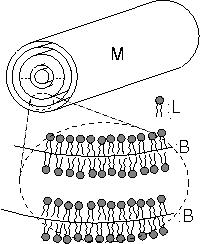
Myelin formation and coiling
|
|
|
Myelin figures or simply, myelins (M) are multilamellar tubes composed of nested cylindrical bilayer membranes (B). The oval inset in the figure shows placements of surfactant molecules (L) in bilayers (B). Typical value of bilayer thickness is about several nanometers and that of myelin diameter is roughly 10 ~ 50 Ám. This means there are hundreds or thousands of bilayers in a myelin. Furthermore, the length of a myelin can be much larger than its diameter. |
|
| The formation of myelins has been a mystery since their discovery in 1854. Myelins are usually produced in contact experiments: water is brought into contact with concentrated surfactant. Immediately after contact, densely packed myelins form at the water-surfactant interface and grow into water (see the figure below). Because bilayers have bending rigidity, myelin formation costs curvature energy. In contrast, flat multilamellae have only minimal curvature energy. Therefore, the puzzling question is why nature favors the formation of myelins rather than flat multilamellae. |
|
A lump of concentrated dilauroyl phosphatidylcholine (DLPC) (bottom) is contacted with water (top) at 27░C. Closely packed myelins form at the interface and grow toward the water-rich side. The bar at the lower left corner represents 100 Ám. (Courtesy of Ling-Nan Zou) |
| My theory of myelin formation is based on the following geometrical fact. The bilayer repeat spacing increases and thus the repulsion between bilayers decreases when a flat multilamella is converted into a myelin without gain or loss of material and with number of bilayers unchanged. This means myelin morphology becomes energetically favorable when the inter-bilayer repulsion is sufficiently large, i.e., when the reduction in the inter-bilayer repulsion can compensate for the curvature energy penalty for myelin formation. See my paper for more details. |
|
| In contact experiments coiling of single myelins or double helix formation of two intertwisting myelins are often observed. Several models have been proposed to explain why myelins coil (see the references in my paper). I proposed a new myelin model, which allows the bilayer cylinders of a myelin to be non-coaxial and the bilayer lateral tension to vary from bilayer to bilayer. In my paper I show that a myelin would bend or coil to lower its energy when the bilayer lateral tension is sufficiently large. From a mechanical point of view, the proposed coiling mechanism is analogous to the classical Euler buckling of a thin elastic rod under axial compression. See my paper for more details. |
Last updated on November 21, 2005.